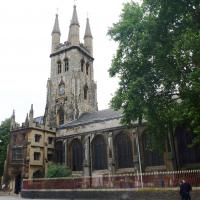The Spanish composer Victoria is regarded as one of the greatest composers of the Renaissance, together with Palestrina and Lassus. He was ordained priest in 1575 and later became chaplain in Madrid to Philip II’s sister, the Dowager Empress Maria. In accordance with ecclesiastical convention, he wrote only sacred music. Tonight’s Mass was published in 1592 in Rome, where he had leave of absence to oversee the publication of this and other works. He remained in Rome, where he had spent much of his early life, for three years, taking part in Palestrina’s funeral cortège in 1594.
Victoria wrote 20 Masses, of which four are based on plainchant and the remainder employ the technique of parody or imitation. Of these, all but four derive from his own compositions. Several of them, including Salve Regina, are based on his own Marian antiphons – hymns to the Virgin Mary in which two choirs sing alternately, one answering the other (the others are Alma Redemptoris and Ave Regina). The Salve Regina Mass employs the same forces as the antiphon (Choir 1 consisting of two sopranos, alto and bass, and Choir 2, soprano, alto, tenor and bass) and its debt to the original antiphon is soon apparent.
The opening section of the Kyrie plays rising against falling figures in each choir before the two come together over a florid line in Bass 1. In the ‘Christe’, by contrast, the voices of Choir 2 first ascend, then descend one after the other. The closing section for both choirs is on a grander scale, Victoria making familiar use of repeated high notes in Soprano 1 to mark the climax. In the few minutes of this opening movement his mastery of counterpoint is clear.
In the Gloria, the soprano and tenor entries echo the ‘Salve’ plainchant. Victoria throws the praises of God in triple time between the two choirs (‘Laudamus te’, etc.), then combines them, back in duple measure, on ‘Gratias’. Chordal antiphony,
again moving to an eight-part resolution, follows. A gentle passage in canon for Choir 1 (‘Domine Deus’) leads to exchanges between the two choirs, perfectly suiting the petititons (‘Qui tollis’, etc.). Soprano 1 rises to repeated high Fs on ‘Tu solus Altissimus’ and the movement concludes in triple time.
The Credo begins with an inversion of the ‘Salve’ chant in soprano and bass. Victoria makes abundant use of antiphony in the praises of God. The Incarnation is marked by broad, falling phrases on the words ‘Et incarnatus est’. There follows the most remarkable section of the Mass: two soprano and two alto parts weave in intricate counterpoint and end with a dramatic suspension on ‘finis’. After that, the composer reverts to chordal antiphony, with two excursions into triple time, before both choirs combine at ‘Et vitam’ in a passage based closely on the final bars of his Salve Regina antiphon.
The Sanctus opens with long melismas for each choir, in which the first syllable is spread over a series of notes. Antiphonal effects follow more closely on each other (‘Dominus Deus’) as the voices move towards ‘gloria tua’. The pattern is repeated in the ‘Hosanna’. The Benedictus, for Choir 1 only, has the pleasing symmetry of rising figures followed by falling ones (‘in nomine’), after which the ‘Hosanna’ is repeated.
Victoria set only the first verse of the Agnus Dei, the second, in plainchant, being supplied by Jon Dixon, editor of the edition being used tonight, and the third repeating the music of the first. The start of the movement echoes the opening of the Gloria, there is a beautiful imitative figure for sopranos on ‘miserere’ and the movement concludes with the composer’s hallmark high Fs from the sopranos of Choir 1.
Composer: Victoria Title of Musical Work: Missa Salve Regina